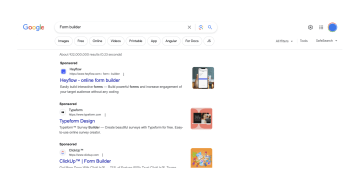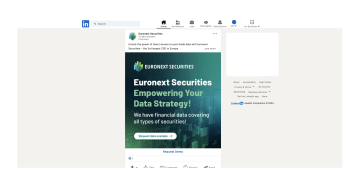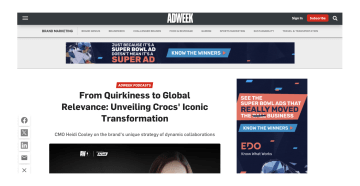Marketing fundamentals
View all articles16 digital ad campaign examples

Most digital ads are like background noise – easy to ignore, hard to remember. But every now and then, a campaign cuts through. It lands the joke. Nails the timing. Sells the thing. And makes the rest of us wonder, how’d they pull that off?
That’s why the best marketers steal – well, study – what works. They look at successful campaigns, figure out what made them work, and use those insights to shape smarter strategies.
In this guide, we walk through standout digital advertising campaigns, break down why they worked, and share tips you can apply to your next one.
What is a digital advertising campaign?
A digital advertising campaign is a strategic plan to promote a product, service, or brand through a series of online advertisements, typically on platforms such as Google, Meta, LinkedIn, YouTube, or display networks.
Ad campaigns are built around a specific goal (like driving leads, sales, or sign-ups) and use a mix of targeting, creative, budgeting, and placement decisions to reach the right audience at the right time.
The strategy includes:
Audience targeting: Defining who you want to reach based on behavior, interests, or demographics
Channel selection: Choosing the platforms where your audience is most active
Creative approach: Designing ad formats (video, image, copy) that match both the channel and campaign goal
Budgeting and bidding: Allocating spend to maximize return across different ad sets or channels
Measurement and optimization: Tracking performance in real time and adjusting based on what’s converting
Types of digital ads in ad campaigns
Whether you’re targeting a warm lead with a product demo or running a top-of-funnel video ad to build brand recognition, every ad format has its strengths and limitations. The key is knowing which ad format to use, when to use it in the funnel, and what role it should play in driving action.
Let’s look at the most common types of digital ads and how they fit into a well-rounded campaign strategy.
Paid search
Best for: capturing high-intent traffic
Also known as: SEM (search engine marketing), PPC (pay-per-click)
Paid search ads (often called search ads) appear at the top of search engine results when someone looks up a relevant term. They’re text-based, keyword-targeted, and great for reaching people with clear intent.
Paid search ads run on a bidding system. When multiple advertisers want to show up for the same keyword, they enter an auction. Each advertiser sets a maximum bid – the highest amount they’re willing to pay for a click.
But Google doesn’t just pick the highest bidder. It also scores each ad based on relevance, expected click-through rate, and the landing page experience.
In short, your ad needs to match what the person searched for, deliver on the promise when they click, and perform well over time. That score, combined with your bid, determines where your ad shows up – and how much you’ll pay.
Let’s say:
You bid $3 for the keyword “home insurance”
A competitor bids $5
But your ad is more relevant, loads faster, and better matches what users are looking for
Google may rank your ad higher even though you bid less, and you might only pay $4.20 to win the top spot. So you’re not just paying for clicks. You’re being rewarded for creating a better user experience.

Paid social
Best for: increasing brand awareness, product launches, driving engagement
Popular formats: video ads, story ads, carousel ads
Paid social media campaigns run on platforms like Instagram, Facebook, LinkedIn, TikTok, and X. These ads can appear as image carousels, video content, text ads, or Stories, and are often boosted by popular hashtags or targeting filters like location, job title, or interests.
Unlike search ads, paid social is more about generating interest than capturing it. You’re reaching people while they scroll, not while they’re searching – so creative content is everything.

Display ads
Best for: brand visibility, retargeting, audience reminders
Often run through: Google Display Network, programmatic platforms
Display ads are the banner-style visuals you see across websites, apps, and sometimes your email inbox. They can include static images, animations, or video, and often follow you around via retargeting campaigns (hello again, shoes you looked at one time).
These ads help build familiarity over time. They’re less about immediate conversion and more about keeping your brand top-of-mind.

YouTube ads
Best for: reaching big audiences with video content
Bonus: great for product demos, launches, and building hype
These are the ads that play before, during, or after a YouTube video. Sometimes skippable. Sometimes not. (Sorry.)
But when done right, they’re powerful. You get a full screen, full sound, and a few golden seconds to tell a story.

Native ads
Best for: driving traffic without disrupting the user experience
Think of it as: advertising that plays nice with content
These ads don’t scream “I’m an ad.” They blend into blog posts, news articles, or recommended content sections (like on Taboola or Outbrain). They look like part of the page, but lead to your campaign.
Sneaky? Maybe. Effective? Definitely.
Influencer + UGC campaigns
Best for: building trust and driving conversions
Why it works: people trust people more than logos
Sometimes the best ad isn’t from your brand – it’s from someone your audience already trusts. That’s where influencer campaigns and user-generated content (UGC) come in.
When you team up with creators to share content about your product on social media, it feels more like a friend’s recommendation than a hard sell.

Now that you know the main types of digital ads and how they show up across the internet, let’s look at how they come together to create effective digital ad campaigns.
16 Digital advertising campaign examples
Below are 16 digital advertising campaigns that didn’t just blend in – they broke through. Some went viral, some drove serious sales, and some just made everyone go, “Damn, that’s smart.”
Let’s dive in and see what you can steal (uh, learn) from them.
1. Oreo – You Can Still Dunk in the Dark
Let’s set the scene. It’s 2013. The Super Bowl is on. Beyoncé just crushed the halftime show. Then – boom – a blackout. The stadium goes dark. Most brands freeze. Oreo? They tweet.
“You can still dunk in the dark.”
That one tweet – quick, clever, and perfectly timed – went viral. It was Oreo’s response to the unexpected Super Bowl blackout, and it became an instant classic in the world of digital advertising campaigns. No flashy video. No paid media.
Oreo reinforced their brand’s playful tone and tapped into a moment the whole internet was talking about. It was part of their larger Wonderfilled campaign, but this tweet is what made marketers everywhere start asking, “Where’s our Oreo moment?”

Source: Oreo Facebook Page, February 4, 2013
📌 Key takeaways:
✅ Be ready to react. If your brand is running a campaign during a live event, have your team (and approvals) in place. You might not get another shot.
✅ Simple can win. You don’t need a high-production budget to make an impact. Just the right idea at the right time.
✅ Stay on-brand. Oreo didn’t try to be something they weren’t. They stayed true to their tone, and it paid off.
✅ Speed + relevance = shareability. The faster you can tie your message to something people care about right now, the better.
2. Swiggy – #VoiceOfHunger
In 2019, India’s food delivery giant Swiggy saw an opportunity in a weirdly wonderful place: Instagram’s new voice note feature.
They challenged users to send voice messages that looked like the shapes of food – yes, like a kebab skewer, nachos, or pancakes – based on the waveform. The result was chaos, creativity, and one of the most delightfully strange digital advertising campaigns of the year.
Users blabbered, hummed, screeched, and gurgled their way into waveforms. Over 1.5 lakh (150,000+) people participated. Instagram had to block the campaign eleven times in one week because it got so popular.
Swiggy replied to people in real-time, teamed up with creators and comedians, and even released behind-the-scenes videos from HQ. All of this made it feel less like a campaign and more like an inside joke the entire internet was in on.
📌 Key takeaways:
✅ Use features, not just platforms. Know the tools and build around them.
✅ Involve your audience. The campaign only worked because people wanted to play along. Give users a role, not just a CTA.
✅ Make it weird (in a good way). Unexpected ideas spark buzz. Don’t be afraid to go off the beaten path – especially in food, lifestyle, or youth-focused markets.
✅ Be ready for real-time chaos. Swiggy had replies, voice notes, influencer content, and campaign films all rolling at once. Prep for the moment – and let it unfold.
3. Dove – Real Beauty Sketches
What do you look like to yourself? What about to someone else?
Dove decided to ask that question in a way no one had before. In their Real Beauty Sketches campaign, they brought in an FBI-trained sketch artist to draw women twice: once based on how they described themselves, and again based on how a stranger described them.
The difference? Huge. And emotional. The stranger’s sketches were warmer, softer, and noticeably more flattering, revealing just how harshly we judge ourselves.
The video struck a nerve. It became the most-watched online video ad at the time, with over 163 million views, 4.6 billion PR impressions, and even earned a Titanium Grand Prix at Cannes Lions.
The campaign was part of Dove’s larger, long-running Campaign for Real Beauty, aimed at challenging narrow beauty standards and building self-esteem, especially among women and girls. But this one hit different. It wasn’t about the product. It was about perspective.

Source: ThinkwithGoogle
📌 Key takeaways:
✅ Tell stories that matter. Ads don’t have to sell. Sometimes they just need to connect.
✅ Emotion drives action. People shared the video because it made them feel something. And that’s way more powerful than a discount code.
✅ Anchor your message in your mission. Dove stayed true to its brand values and built real trust.
✅ Invest in distribution. Dove didn’t just upload a video and hope. To build momentum, they backed it with YouTube ads, search placements, homepage takeovers, and influencer content.
4. Airbnb – #WeAccept
Sometimes, the most powerful digital advertising campaigns don’t promote a product – they promote a principle.
In 2017, Airbnb launched #WeAccept, a bold campaign rooted in one simple message: everyone belongs. It was a direct response to both internal criticism (guests facing discrimination on the platform) and external events, specifically, the U.S. travel ban targeting several Muslim-majority countries.
Rather than stay quiet, Airbnb took a stand. They aired a powerful 30-second Super Bowl ad showcasing portraits of people from all walks of life, accompanied by a message of inclusion.
The campaign came with action: Airbnb pledged to provide short-term housing to 100,000 refugees and displaced people, and committed $4 million to the International Rescue Committee.
📌 Key takeaways:
✅ Be about more than business. People expect brands to take a stand, especially when it aligns with their mission.
✅ Timing matters. Launching this campaign during the Super Bowl, just after the travel ban, made the message impossible to ignore.
✅ Back it up. Airbnb didn’t just say “we accept.” They gave homes, donated millions, and created infrastructure for others to help.
✅ Invite others in. From influencers to hosts to everyday users, Airbnb encouraged people to share, support, and participate.
5. Apple – Shot on iPhone
Apple didn’t tell you their camera was good. They let you show it.
Their Shot on iPhone campaign flipped traditional advertising on its head by handing the spotlight to users. Apple invited people to share their iPhone photos using the hashtag #ShotoniPhone – and turned their real, everyday moments into billboard ads, TV spots, and in-store displays around the world.
A dog mid-sneeze. A kid mid-air. A sunset that looked too good to be real. No celebrity photographers. Just regular people with great timing and an iPhone in their pocket.
What started in 2015 as a campaign for the iPhone 6s camera quickly grew into one of the most iconic user-generated content campaigns in digital marketing history, with over 16 million #ShotoniPhone posts on Instagram (and counting).
Bonus: Apple even curates a YouTube playlist of full-length films and creative shorts shot entirely on iPhone, proving that anyone can create cinema-worthy content with the right tools.

📌 Key takeaways:
✅ Give your users the mic. Let your audience be part of the story. People trust people more than brand copy.
✅ Design with confidence. Apple didn’t clutter the message – they let the creative speak for itself.
✅ Consistency scales. This wasn’t a one-off. Apple built a repeatable framework that evolved with each iPhone release.
✅ Make people proud to participate. When customers feel like they’re contributing to something bigger, they show up (and share).
6. Orange France – Gender Bias in Football
What if the only thing stopping people from appreciating women’s football was knowing it was women’s football?
That’s exactly the question Orange France posed with its mind-bending campaign, La Compil des Bleues. Released ahead of the 2023 Women’s World Cup, the ad starts out like a typical highlight reel – jaw-dropping moves, slick passes, and goals from big-name male players like Mbappé and Griezmann.
Or so it seems.
Halfway through, the illusion drops. Turns out, those weren’t the men’s highlights at all – they were real plays by France’s women’s national team, with the players’ faces digitally swapped using VFX and AI. The message? Great football is great football – no matter who’s playing.
📌 Key takeaways:
✅ Make your audience feel something. Surprise and emotion are what make messages stick and get shared.
✅ Flip assumptions on their head. If your audience holds a bias, challenge it in a way that lets them discover it for themselves.
✅ Invest in the craft. This campaign worked because the editing was that good. It had to be.
✅ Back your message with action, and make a statement. Orange has supported both the men’s and women’s teams equally since 2018.
7. Flo Health – Instagram-Style Pregnancy Stories
Flo Health, one of the most downloaded women’s health apps globally, knows that digital marketing isn’t just about reach – it’s about relevance. And when it came to supporting pregnant users, they completely reimagined the experience.
Instead of long-form articles, Flo launched Instagram-style stories inside their app – snackable, interactive, and beautifully designed to match where users already spend their time. Each story was personalized to a user’s week of pregnancy, using AI-powered insights and health data to deliver exactly what they needed, when they needed it.
📌 Key takeaways:
✅ Adapt your format to user behavior. If your audience lives on social media, meet them there with content that feels familiar.
✅ Combine personalization with scale. Flo built over 330 unique stories, yet each felt tailored thanks to smart automation and data use.
✅ Let SEO drive strategy. Top-searched questions inspired high-performing stories, blending content marketing with real demand.
✅ Use content to convert. The stories led to an 80% boost in trials and major growth in premium subscriptions.
8. Barbie – The Movie Marketing Phenomenon
The 2023 Barbie film campaign was a cultural takeover. From hot pink Xbox consoles and Zara collabs to a fully bookable Dreamhouse on Airbnb, Barbie’s marketing didn’t just show up in your feed – it showed up everywhere.
And that was the point.
With a marketing strategy spanning digital, social media platforms, experiential pop-ups, and over 160 global brand partnerships, Barbie the Movie blurred the line between entertainment and lifestyle. People dressed in pink, themed their parties, and made #BarbietheMovie trend for months. It became the benchmark for modern marketing campaigns and a masterclass in creating creative content that converts.

Source: Airbnb
📌 Key takeaways:
✅ Create a world, not just a message. Barbie’s team built a full brand universe where fans could dress up, play, and participate.
✅ Let your audience take the wheel. The best content wasn’t created by the brand – it was amplified by millions of fans on social media.
✅ Blend paid, earned, and experiential ads. From bold teaser trailers to real-world Dreamhouses, the campaign hit every major touchpoint.
✅ Own your visual identity. Barbie Pink became the color of the summer. Distinctive design can carry a campaign further than words.
9. Arsenal x adidas – No More Red
Arsenal’s No More Red campaign, created in partnership with adidas, goes far beyond the pitch. Launched in 2022 and now in its fourth year, this powerful initiative tackles the root causes of youth violence in London.
Instead of promoting merch, Arsenal took a bold stand: the all-white No More Red shirt isn’t for sale. It’s awarded only to individuals making a positive impact in their community.
📌 Key takeaways:
✅ Purpose is powerful. When brands use their platform to spotlight real issues, they build real trust.
✅ Community is content. Arsenal didn’t create fictional stories – they elevated real people doing real work.
✅ Symbolism scales. A white kit you can’t buy is more memorable than a thousand jersey ads.
✅ Marketing can move people. This campaign drove conversations, not conversions – and that’s exactly what made it stand out.
10. Liquid Death – Marketing Spoof (aka “badvertising” done brilliantly)
How do you stand out in the crowded, overly-zen world of bottled water? Easy. You do the exact opposite of everyone else.
Liquid Death sells plain water. In cans. With branding that screams death metal and marketing that could double as late-night sketch comedy. One of their infamous digital advertising campaigns featured The Deep – one of the morally questionable superheroes from The Boys – lecturing kids on the dangers of sugary drinks while handing out cigarettes and cups of sugar. 😬
Yes, it was chaotic. Yes, it sparked backlash. And yes, it totally aligned with Liquid Death’s digital advertising strategy: shock, satire, and staying true to their anti-corporate, anti-boring brand.
📌 Key takeaways:
✅ Marketing campaigns don’t need to be serious to be successful. Sometimes the best digital advertising strategy is simply to be unforgettable.
✅ Embrace your brand voice – loudly. Liquid Death doesn’t dilute their tone for anyone. And their digital ad campaigns shine because of it.
✅ User-generated content helps carry the chaos. Fans reposted, re-memed, and reenacted moments, boosting reach organically.
✅ Know your limits. Then maybe cross them. The Deep’s campaign flopped – but the brand used the backlash as part of the performance.
11. SoFi – Face of Finance
SoFi set out to challenge how we see financial success – literally. The campaign exposed how AI image generators overwhelmingly associate wealth and financial expertise with men, despite women statistically crushing it when it comes to investing, saving, and debt management.
The brand launched a powerful video, gathered top female finance influencers in Times Square, and set up a photo booth that let women upload their portraits to help retrain biased algorithms. Social media lit up with women sharing their financial goals – and SoFi rewarded some of them with surprise deposits.
The results were 81 million impressions, 39 million views, 22 million engagements, and a 42% jump in unaided awareness. A mic-drop moment in inclusive digital marketing.
📌 Key takeaways:
✅ Fixing bias is bold and shareable. SoFi didn’t just call it out, they showed people how to change it.
✅ Data doesn’t lie: if your audience is crushing it, show it off.
✅ Add action. From photo booths to surprise deposits, SoFi gave people ways to do something.
✅ Don’t just speak to a movement. Help drive it.
12. Domino’s – RIP Campaign
Pineapple on pizza: a debate as old as time (or at least the internet). Domino’s leaned all the way in by holding a full-on funeral for their Hawaiian pizza, complete with Taiwanese funeral rites, influencer “mourners,” and black-clad branding. The drama? Delicious.
The campaign struck a cultural nerve, blending humor, local traditions, and online chaos to perfection. Once the RIP vibes had gone viral, Domino’s flipped the script: Hawaiian pizza was back, now with locally sourced pineapple – because what’s dead may never die (especially if it tastes good).
📌 Key takeaways:
✅ Done right, tapping into divisive topics (like pineapple on pizza) can be marketing gold.
✅ Cultural relevance adds emotional weight even in digital ad campaigns.
✅ Local sourcing made the relaunch more meaningful, not just a gimmick.
✅ Turning a “product funeral” into a fan-fueled spectacle is a bold (and brilliant) move.
13. Britannia – Prashant Croissant
A croissant by any other name might just go viral. After a digital creator hilariously mispronounced "croissant" as "Prashant," the internet erupted – and Britannia did what any meme-literate brand should: it ran with it.
The brand temporarily rebranded its Treat Croissant to Prashant, changed its social handles to @Britannia.Prashant, and slapped the new name on actual product packaging. They even sent a personalized “Prashant” hamper to the creator behind the viral video.
It was cheeky. It was chaotic. And it was a masterclass in real-time, culturally fluent marketing. Other brands jumped in, users posted their own croissant-turned-Prashant memes, and suddenly, baked goods were the main character online.

Source: Britannia on Instagram
📌 Key takeaways:
✅ Don’t just join the internet – listen to it. That’s where the gold is.
✅ Humor + quick reflexes = maximum engagement.
✅ Even FMCG giants can be meme-friendly if the tone is right.
✅ UGC is your best friend. Let your audience lead the joke, then follow through like a pro.
14. Pepsi – Your Bites, Your Rights
What happens when Pepsi hands over the chef’s hat? You get AI-powered parmegiana shepherd’s pie, that’s what. In this one-of-a-kind campaign, Pepsi teamed up with a bar in São Paulo and replaced menus with voice-controlled tablets. Guests could invent wild new dishes – anything their imaginations could conjure – and watch them come to life on a plate.
Your Bites, Your Rights turned food into a personalized digital ad campaign, combining tech, taste, and storytelling to make Pepsi the flavor of the experience. And because this is 2025, it also lived on TikTok, Instagram, and Meta – complete with influencers, custom UGC, and a few “wait, is that edible?” moments.
📌 Key takeaways:
✅ Personalization is powerful – especially when it’s edible.
✅ AI isn’t just for automation. It can be a creative sidekick.
✅ Combining physical experiences with social buzz? Chef’s kiss.
✅ Brand positioning doesn’t need to be loud – it just needs to show up at the right moment.
15. Little Caesars – Burn the Burns
Pizza with a side of petty? Yes please. Little Caesars tackled hate comments head-on by literally burning them. In this hilarious TikTok campaign, the brand turned real troll comments into wood planks, threw them into a bonfire, and cooked pizzas over the ashes. The haters were invited to the feast – to eat their own words.
But wait, there’s more: Disaster Girl (yes, that meme icon) hosted the event with her signature smirk, and TikTok ate. it. up. No promos, no new products – just good ol’ fashioned chaos, internet culture, and a 30-foot pizza fire.
📌 Key takeaways:
✅ Hate comments can be fuel if you know how to roast them.
✅ Pop culture icons bring instant nostalgia and shareability.
✅ A bold brand voice + social-first creativity = high-impact engagement.
✅ You don’t need a promo to go viral. Just start a bonfire.
16. KFC – FCK
Imagine running a chicken restaurant with no chicken. That’s exactly what happened to KFC UK in 2018 when a botched logistics switch left them with empty kitchens and 900+ closed stores. But instead of hiding behind bland PR statements, KFC served up one of the smartest crisis responses in ad history.
They took out a full-page newspaper ad featuring an empty bucket with the letters rearranged to spell “FCK.”
Just a bold, funny, and very British apology that said it all: “A chicken restaurant without any chicken. It’s not ideal.”
The tone was humble, human, and hilariously on-brand. The result? A viral sensation, more than a billion impressions, and a whole lot of goodwill from customers who felt seen (and slightly amused).
📌 Key takeaways:
✅ When in crisis, lead with honesty – and maybe a cheeky sense of humour.
✅ A well-placed print ad can still break the internet.
✅ Customers don’t expect perfection, but they appreciate humility.
✅ FCK-ups don’t have to be fatal. They can even boost brand love – if you handle them right.
Best practices for setting up a successful ad campaign
Before you set up your own digital ad campaign, you need to assess what applies to your specific situation. Consider your audience, understand your business objectives, and make decisions based on those factors.
Start with intent: Cover bottom-of-funnel first. That is, before splashing out on brand awareness, make sure you're capturing existing demand. Running Google Search Ads is one of the lowest-hanging fruits – you’re meeting users at the moment they’re searching for your solution. Start there before exploring broader, top-of-funnel platforms.
Test, don’t guess: There’s no “best” ad platform – just the best one for you. Try different channels (Google, Meta, LinkedIn, YouTube) and see what delivers. But do it systematically: change one variable at a time, track your metrics, and optimize.
Let the algorithm learn: Don’t expect magic overnight. Most platforms need 4–6 weeks to learn and optimize. Be patient. Let your campaign run long enough to gather insights before making changes.
Don’t skip the boring stuff (like budgeting): Work backwards from your conversion goals to estimate how much to spend. For example, if you need 10 conversions per day and each costs $10, that’s $3,000/month. Use tools like the HubSpot Ad Calculator to play with projections.
Match platform to purpose
Google Ads: High intent, bottom-funnel
Meta & LinkedIn: Awareness and demand gen. Meta is cheaper; LinkedIn is precise but pricier.
YouTube Ads: Great for storytelling if you have video chops.
Display ads: Not conversion-driven. Do this last.
Don’t spread yourself too thin: Instead of launching 15 mediocre campaigns, focus on a few well-structured ones. Nail your messaging and targeting before scaling.
Iterate on creatives: If you’re running a longer campaign, swap in new creatives every few weeks to keep things fresh. See what performs better, and learn from your winners.
It’s your turn to break the internet (in a good way)
If there’s one thing these campaigns prove, it’s that the best digital advertising is about being memorable in the right moments. Whether it’s KFC owning a blunder with humor, Pepsi turning dinner into a co-creation experience, or Britannia renaming a croissant after an internet joke, the most impactful brands today are the ones that move fast, take risks, and stay deeply in tune with their audience.
When you’re ready to put all this inspiration into action, Heyflow is here to help you build campaigns that capture attention – and convert it. With Heyflow, you can create interactive, no-code flows that make lead gen feel less like a chore and more like a moment.
So the next time inspiration strikes (or your pizza goes viral), make sure you’ve got the setup to keep up.
--------------------
Turn clicks into conversions
Whether you're launching your first ad or rethinking your funnel, Heyflow gives you the tools to build high-converting experiences – without a single line of code.


